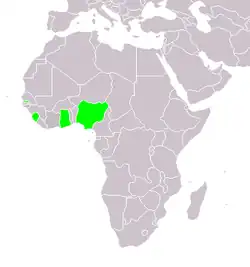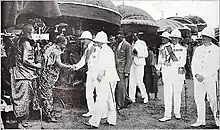British West African Settlements | |||||||||||||
|---|---|---|---|---|---|---|---|---|---|---|---|---|---|
| 1821–1850 1866–1888 | |||||||||||||
.svg.png.webp) Flag
.svg.png.webp) Badge
| |||||||||||||
| Anthem: God Save the King (1821–1837) God Save the Queen (1837–1850; 1866–1888) | |||||||||||||
 Location of British West Africa. From left to right: The Gambia, Sierra Leone, Gold Coast and Nigeria. | |||||||||||||
| Status | Crown colony | ||||||||||||
| Capital | Freetown | ||||||||||||
| Common languages | English (official) | ||||||||||||
| Government | Crown colony | ||||||||||||
| Monarch | |||||||||||||
• 1821–1830 | George IV (first) | ||||||||||||
• 1837–1850; 1866–1888 | Victoria (last) | ||||||||||||
| Historical era | Abolitionism New Imperialism | ||||||||||||
• Established | 17 October 1821 | ||||||||||||
• Disestablishment | 13 January 1850 | ||||||||||||
• Second establishment | 19 February 1866 | ||||||||||||
• Final disestablishment | 28 November 1888 | ||||||||||||
| Currency | Pound sterling British West African pound | ||||||||||||
| |||||||||||||
| Today part of | The Gambia Ghana Nigeria Sierra Leone Cameroon | ||||||||||||
British West Africa was the collective name for British colonies in West Africa during the colonial period, either in the general geographical sense or the formal colonial administrative entity. British West Africa as a colonial entity was originally officially known as Colony of Sierra Leone and its Dependencies, then British West African Territories and finally British West African Settlements.[1]
The United Kingdom held varying parts of these territories or the whole throughout the 19th century. From west to east, the colonies became the independent countries of The Gambia, Sierra Leone, Ghana and Nigeria. Until independence, Ghana was referred to as the Gold Coast.
Historical jurisdiction


British West Africa constituted during two periods (17 October 1821, until its first dissolution on 13 January 1850, and again 19 February 1866, until its final demise on 28 November 1888) as an administrative entity under a governor-in-chief (comparable in rank to a governor-general), an office vested in the governor of Sierra Leone (at Freetown).[1]
The other colonies originally included in the jurisdiction were the Gambia and the British Gold Coast (modern Ghana). Also western Nigeria, eastern Nigeria and northern Nigeria were included.[2]
Africa's present makeup includes Ghana, Sierra Leone, Gambia, Western Nigeria, Eastern Nigeria and Northern Nigeria. These countries and areas are artifacts of the post-colonial period, or what the Ghanaian writer Kwame Appiah dubs neo-colonialism.
British West Africa was originally founded at the urging of the prominent abolitionist Fowell Buxton, who felt that ending the Atlantic slave trade required some level of British control of the coastline.[3] Development was solely based on modernization, and autonomous educational systems were the first step to modernising indigenous culture. Cultures and interests of indigenous peoples were ignored. A new social order, as well as European influences within schools and local traditions, helped mould British West Africa's culture. The British West African colonial school curriculum helped play a role in this. Local elites developed, with new values and philosophies, who changed the overall cultural development.[4]
Aftermath
Even after its final dissolution, a single currency, the British West African pound, was in effect throughout the region—including Nigeria—from 1907 to 1962.
Nigeria gained independence in 1960. Sierra Leone was self-governing by 1958 and gained independence in 1961. Gambia gained independence in 1965. In 1954, the British Gold Coast was allowed by Britain to self-govern and in 1957, the Gold Coast was given independence from Britain, under the name Ghana.[5]
See also
- British colonisation in Africa
- European colonisation in Africa
- Scramble for Africa
- West Africa cricket team
References
- 1 2 "Sierra Leone". WorldStatesmen.org. Retrieved 30 December 2018.
- ↑ Lange, Matthew (2006). "Colonialism and Development: a comparative analysis of Spanish and British colonies" (PDF). American Journal of Sociology. 111 (5): 1412–1462. doi:10.1086/499510. JSTOR 10.1086/499510. S2CID 142835054.
- ↑ The African Slave Trade and its Remedy (1839) at the Internet Archive
- ↑ Szücs, Stefan; Strömberg, Lars (17 August 2007). Local Elites, Political Capital and Democratic Development: Governing Leaders in Seven European Countries. Springer Science & Business Media. ISBN 978-3-531-90110-7.
- ↑ "Britannica Academic". academic.eb.com. Retrieved 4 February 2020.
External links
 Media related to British West Africa at Wikimedia Commons
Media related to British West Africa at Wikimedia Commons